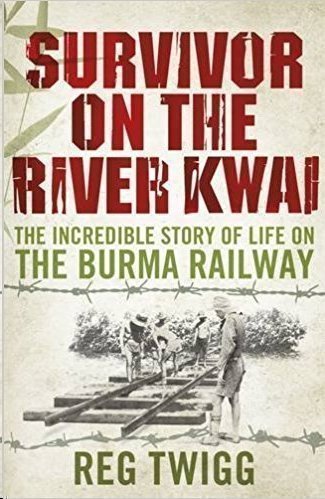"Survivor on the river Kwai" by Reg Twigg

I knew a fair amount about the Pacific War when it involved the United States. But, the Brit's fiasco in Singapore had eluded me... until this trip (Bangkok to Abu Dhabi via Regent, Seven Seas Voyager, 08 April 2017 to 03 May 2017.
I completed reading this book today, 02 May 2017. "Survivor on the River Kwai, The Incredible Story of Life on the Burma Railway" by Reg Twigg today. 302 pages.
I bought the book at the Changi Museum store in Singapore earlier in the month.
Margaret and had cruised, on Regent Cruise Lines' Seven Seas Voyager, from Bangkok, south down the eastern side of the Malay Peninsula, past the beaches stormed by the Japanese at the outset of WWII. Knowing that our voyage would take us via Singapore, through the Malacca Straits and back up the west side of the Malay Peninsula to Burma, I felt that reading something as we sailed the area would give more purpose to our visit.
After storming the Malay eastern beaches, Japanese troops moved south, many of them riding bicycles, to attack the British stronghold of Singapore only three weeks after landing. Singapore fell to the Japanese in mid February 1942. Churchill called the fall of Singapore the worst defeat in British military history.
The Brits had 120K troops... the Japanese only half that. But, the Japanese had tanks and planes to redress the imbalance. While in Singapore, in addition to visiting Changi POW camp, Margaret and I visited the Battlebox, the command center of General Percival, the British commander. We were reminded of our visits to Corregedor, in Manila Bay, where US General Jonathan Wainwright, was holed up before surrendering, in late December 1941, US forces in the Philippines to the Japanese. McCarthur had been the commander in the Philippines, but Roosevelt ordered his escape to Australia to prepare for a counter attack against the Japanese.
About 60K British prisoners of war were transported from Changi POW camp in Singapore, in stifling box cars, 650 miles north to work for the Japanese on the Rangoon Bangkok railway. Japan needed Burma as a buffer against British reprisals coming from India. They could sail around the Malay peninsula, but they would have to go through the Straits of Malacca and there they feared British submarines would thwart their efforts.
So... they built a railroad... from Bangkok to Rangoon. In addition to the 60K British POW's, over 100K contract workers from Thailand and Malaya participated in the project.
The book is one of Reg Twigg's reminiscences of his time working on the "Death Railroad" from June of 1942 to August of 1945 of a British private from Leicester... three Christmases as Private Reg Twigg poignantly put it.
Reg Twigg moves from jungle camp to jungle camp working for the Japanese. He was regularly beaten, tortured and made to watch his mates die. The men were starved as all the Japanese provided in the way of food was rice pap. Twigg talks of using his wits to trap lizards for protein and to risk his life doing an occasional raid of the Japanese's pantry. Reg's will to survive through great suffering persisted throughout the three years... where other troops gave up or made mistakes raising the ire of their cruel captors.
Of the 60K British troops sent to the railway, 10K died.
Some of the most moving parts of Twigg's account come near the end of the book when the hopeless men receive signs that the war may be coming to the end. They see it in the dour, dispirited looks of their captors. Also, in 1945, British "Mosquitos" start over-flying the railway and succeed in destroying some of the bridges. To be sure, near the end the POWs worry that their captors will use the turning tide of the war to further abuse them. David Lean's film, "Bridge on the River Kwai" was a well received effort to depict life of POWs on the "Death Railway."
The abject cruelty of the Japanese (understated in Lean's film), was far outside what was stipulated by the Geneva Convention. The book caused me to wonder what there was, deep down, in the Japanese character that I may have missed during the remarkable three years that I lived in Japan in the early '80's.
Some thirty-five Japanese soldiers who oversaw POWs on the "Dealth Railway" were convicted of war crimes. Some were executed and the rest were incarcerated, usually for then to fifteen years.
Margaret and I visited the Taukken war cemetery in Yangon, Myanmar (Rangoon, Burma) on 17 April 2017. There 6500 British troops (of which 1700 Indian troops) were entombed. Most of these soldiers were from regular units working to take back the Malay Peninsula. The casualties of the "Death Railway" were buried along the railway in tombs, today, known only to God.
The railway operated for about two years. It was, by international engineering consensus, a marvel. The railway had over sixty bridges. It ran for about 180 miles.
Today there is no rail connection between Yangon and Bangkok. The Thais have kept their side running, more as a tourist attraction.
I enjoyed the book. There are probably more scholarly books on this topic. I picked up this one in a hurry. A good ghost writer has helped Reg write in a good, working class colloquial style. I enjoyed the read, particularly as a complement to our cruise journey - in a style that the British POWs could have only dreamed of.
I knew a fair amount about the Pacific War when it involved the United States. But, the Brit's fiasco in Singapore had eluded me... until this trip.